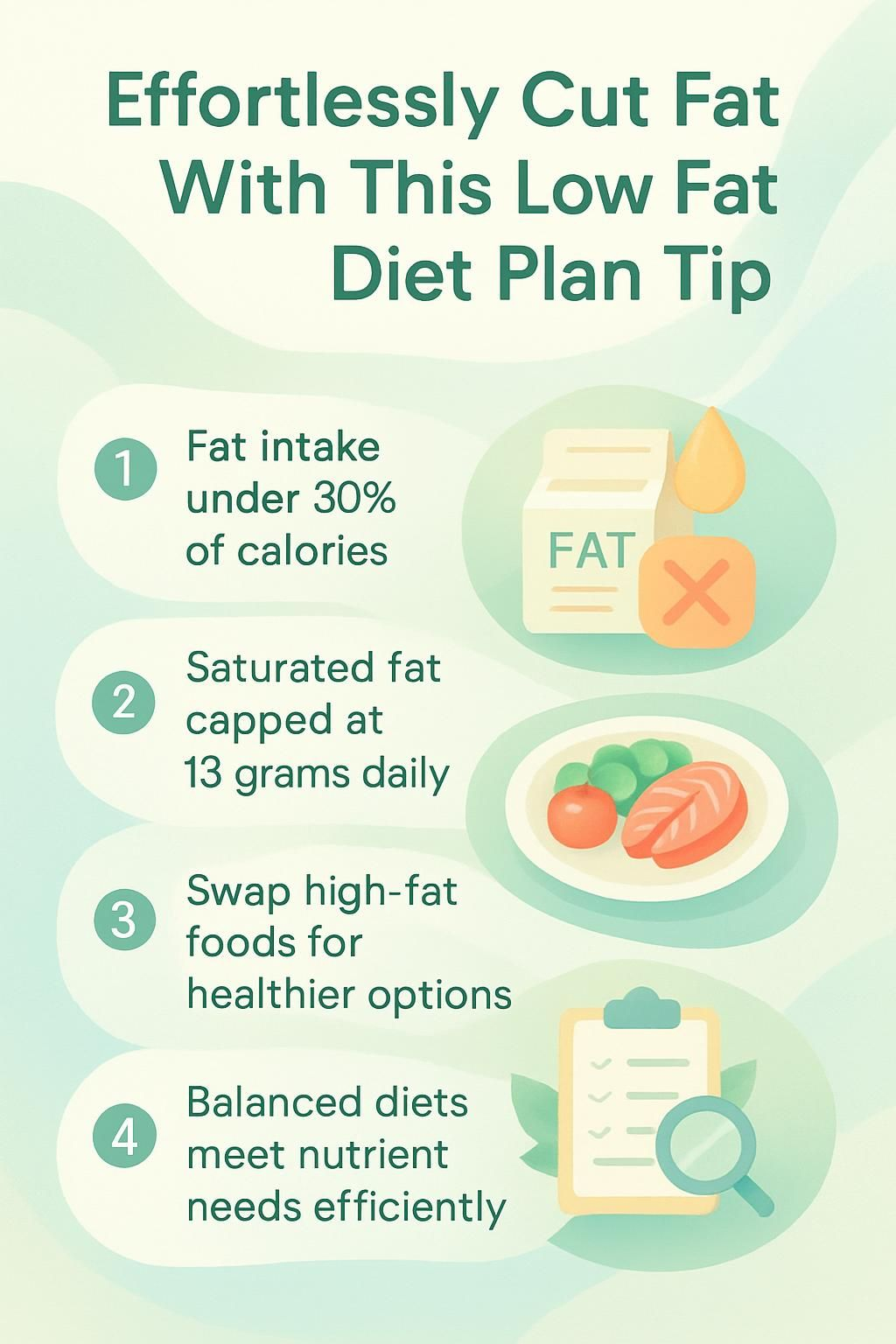Effortlessly Cut Fat With This Low Fat Diet Plan Tip
Our Nutrition Assistant AI Suite will transform your body. You will lose fat, get toned, and build muscle. Gain confidence and optimal health.
Cutting fat from daily meals can feel hard, yet small steps make a big difference. A low-fat diet plan keeps fat intake under 30 percent of total calories, which helps protect your heart and manage weight. This guide shows you how to choose better foods, understand labels, and cook with less saturated fat without losing flavor.
Inside, you will learn simple swaps, smart cooking methods, and practical tips you can use today. The goal is clear choices that fit your life and help you feel better each day.
Key Takeaways
- Keep total fat under 30% of daily calories on a low-fat diet plan, a level supported by the USDA and American Heart Association for heart health.
- Limit saturated fat to about 13 grams per day on a 2,000-calorie diet to help lower LDL cholesterol.
- Choose lean proteins, whole grains, fruits, vegetables, and low-fat dairy to support weight control and improve markers tied to metabolic syndrome.
- Evidence summaries, including StatPearls and the Dietary Guidelines for Americans, 2020–2025, show balanced low-fat eating can meet nutrient needs without excess calories from fat.
- Reading food labels helps you avoid hidden fats; green or amber codes signal better choices for each meal.

What Is a Low-Fat Diet Plan?

A low-fat diet plan limits total fat to no more than 30 percent of your daily calories. This approach encourages you to eat more fruits and vegetables, whole grains, lean protein like chicken or fish, and low-fat dairy such as skim milk or reduced-fat yogurt.
Foods labeled low-fat should contain less than 3 grams of fat per 100 calories per serving under the Dietary Guidelines for Americans, 2020–2025. Government groups like the United States Department of Agriculture and the Department of Health and Human Services support this style of eating because it helps control cholesterol and supports heart health.
Many people borrow ideas from DASH or Mediterranean-style eating. I swapped full-fat cheese for reduced-fat cheese on pizza last month. The taste was great, and my saturated fat intake went down.
Good everyday options include beans, brown rice, egg whites, vegetable soups, oven-roasted potatoes, plain yogurt with fruit, and grilled meats.
Low-fat diets have been shown to lower blood cholesterol levels when followed correctly.
Reviews such as StatPearls note that a balanced low-fat plan can meet your nutrient needs while limiting extra calories from fat.
What Are the Benefits of a Low-Fat Diet?
Shifting to foods low in fat often means more vitamins, minerals, and fiber on your plate. Many people notice improvements in energy, heart markers, and weight when they reduce fatty foods and focus on nutrient-rich choices.
How Does a Low-Fat Diet Boost Heart Health?
Heart disease is a leading cause of death in the United States. Eating a lot of saturated fat raises LDL, the “bad” cholesterol that can clog arteries and increase the risk of heart attack or stroke.
The American Heart Association suggests limiting saturated fat to 5% to 6% of daily calories. For a 2,000-calorie diet, that equals about 13 grams per day. Replacing butter and cream-based sauces with olive oil, and choosing lean cuts of meat, can improve cholesterol numbers.
Foods rich in unsaturated fats, such as nuts and vegetable oils, help lower LDL while supporting HDL, the “good” cholesterol. Cutting back on high-fat snacks, bacon, processed meats, and rich desserts supports cardiovascular health.
Using healthier methods like baking or grilling reduces added fat and keeps important vitamins and minerals intact.
Can a Low-Fat Diet Help with Weight Loss?
High-fat, high-sugar foods pack a lot of calories in small amounts. That can lead to weight gain. A low-fat diet lowers total calories by swapping fatty foods like creamy spreads, mayonnaise, and high-fat meats for lighter choices.
Research on energy density shows that lower-fat foods often have fewer calories, yet can still keep you full. I replaced breakfast sausage with a veggie burger on whole grain bread and felt satisfied for hours while eating fewer calories.
Filling your plate with fruits, vegetables, and lean proteins supports steady weight loss and better blood pressure over time.
How Does It Lower the Risk of Chronic Diseases?
Lowering saturated and trans fat can reduce the risk of several chronic diseases. The National Cancer Institute reports that higher fat intake is linked with greater risk for some cancers, including breast and colon cancer.
Choosing fiber-rich foods and plant-based meals helps control cholesterol and blood pressure. Pick whole foods like cereal made from whole grains, simple pasta sauces, crisp cucumbers, and lean proteins instead of creamy or oily dishes.
After moving from processed snacks to whole grains and low-fat dairy drinks, my blood sugar improved within three months. Healthy eating plus regular activity can reduce obesity, stroke risk, and high blood pressure.
What Are the Metabolic Health Benefits of a Low-Fat Diet?
A low-fat diet can improve markers tied to metabolic syndrome, such as high LDL and abdominal obesity. A 2020 review in Nutrients reported that limiting fat supports better blood lipid control and may reduce waist size.
People often eat more fruits, whole grains, and lean proteins on this plan, which steadies carbohydrate intake. Plans like DASH also limit sodium, a habit that helps lower blood pressure and supports blood sugar control.
When I followed a Mediterranean-style plan low in saturated fat, my energy improved and my lab results trended better across the year. Better insulin sensitivity often follows these habits, which supports long-term metabolic health.
How Does a Low-Fat Diet Support Digestion?
Fiber from fruits, vegetables, and whole grains keeps digestion regular. It adds bulk to stool and supports healthy gut bacteria.
Legumes like beans, peas, and lentils offer both soluble and insoluble fiber, two types that work together to aid digestion. Heavier, fatty meals can slow the process and cause discomfort.
Sports nutrition experts often suggest lower-fat meals before training to reduce sluggishness. After shifting to more grains, vegetables, and legumes, my digestion felt easier within two weeks. Fiber-rich eating also helps with mineral absorption and steady fullness.
Key Foods to Include in a Low-Fat Diet
Low-fat foods help you meet nutrition needs without a lot of extra calories from fat. Focus on colorful produce, lean protein, whole grains, and low-fat dairy to protect your heart and support steady energy.
Which Fruits and Vegetables Are Essential?
Build your meals around a variety of fruits and vegetables. Snack ideas like one cup of baby carrots and one cup of mixed berries provide fiber and antioxidants with very little fat.
Add a medium apple at lunch and a medium orange for dessert to boost vitamin C and natural sweetness. Cooked zucchini makes a great side at dinner with very few calories. Leafy greens like spinach or romaine deliver potassium, iron, and magnesium without adding much fat.
Working with a registered dietitian, I found that mixing colorful produce with whole grains kept me full and supported healthy cholesterol numbers.
What Are Good Lean Protein Sources?
Lean protein helps you feel full and supports muscle health while keeping saturated fat low. Try two scrambled egg whites for a light breakfast protein.
For lunch, sliced turkey breast offers a low-calorie, low-saturated fat option. Grilled salmon brings omega-3 fatty acids, which support heart health.
Plant proteins like beans and lentils provide fiber and very little saturated fat. Choosing lean proteins helps you meet your needs without raising fat intake.
Which Whole Grains Should You Eat?
Oatmeal is a strong breakfast choice. One cup cooked offers fiber that helps lower cholesterol and supports fullness. Brown rice pairs well with vegetables and lean protein at dinner.
Whole grain bread adds fiber to sandwiches and supports steady energy. Other smart picks include quinoa, barley, bulgur, and farro. These grains support heart health and digestion.
Check labels to confirm you are buying true whole grain products, not refined grains with added coloring or marketing claims.
What Are Healthy Low-Fat Dairy Options?
Low-fat yogurt and reduced-fat cheese offer protein and calcium with less saturated fat. Skim milk and 1% milk supply similar nutrients as full-fat milk with fewer calories and less fat.
Use nonfat milk in coffee or cereal instead of cream. A small serving of low-fat ice cream can fit into your plan too.
These swaps made it easier for me to stay within daily fat goals while still enjoying familiar foods.
How Much Healthy Fat Is Safe to Eat?
Choose healthy unsaturated fats like olive oil, nuts, and avocado. Aim to limit saturated fat to about 13 grams per day on a 2,000-calorie diet, in line with American Heart Association guidance. In the UK, men are advised to stay under 30 grams and women under 20 grams of saturated fat per day.
Use small amounts of oil in cooking or salads instead of butter or cream sauces. Switching from deep-fried snacks to a small handful of baked nuts helped me feel less sluggish and made tracking fat intake easier.
Read labels to monitor fat and serving sizes so your choices match your goals.
What Foods Should You Avoid or Limit on a Low-Fat Diet?
Some foods add a large amount of unhealthy fat to your day. Limiting these items helps you hit your targets and supports heart health.
Which Foods Contain Saturated Fats to Limit?
Butter, ghee, suet, and lard are high in saturated fat. Tropical oils like coconut and palm oil add many saturates too. Cakes, biscuits, pastries, and chocolate spreads can quickly raise your intake, and labels often show more than 5 grams of saturates per 100 grams.
Fatty meats such as sausages, bacon, salami, and chorizo are major sources. Full-fat dairy like cream, crème fraîche, sour cream, and ice cream add even more saturated fat. Coconut milk and some milkshakes hide additional saturates.
UK guidance suggests men keep saturated fat under 30 grams per day and women under 20 grams. On packages, a red label signals high levels. Swapping high-fat cheese for low-fat yogurt or skipping bacon at breakfast helped me stay within safe limits.
Why Avoid Trans Fats and Which Foods Contain Them?
Trans fats raise LDL and lower HDL, which increases heart risk. Packaged cookies, crackers, and many fried foods often contain trans fats due to longer shelf life.
Even if a label reads “0 grams,” a product can include up to 0.5 grams per serving. Check the ingredient list for partially hydrogenated oils. After finding that on a snack I liked, I switched to fresh fruit or homemade options.
Limiting trans fats supports heart health and helps you stick to a low-fat plan.
What High-Fat Sauces Should You Minimize?
Mayonnaise, creamy dressings, and rich gravies add a lot of fat and calories. Cheesy sauces like Alfredo and carbonara are also heavy.
Use tomato-based sauces to cut saturated fat without losing flavor. In my meals, swapping creamy dressings for simple vinaigrettes made dishes feel lighter and supported weight goals.
USDA data show two tablespoons of mayonnaise can add up to 180 calories and about 20 grams of fat. Choose low-fat alternatives or brighten dishes with fresh herbs and spices.
How Can You Cut Fat from Your Diet Effortlessly?
Small changes add up. Learn to read labels, pick low-fat cooking methods, choose fresh foods, and swap high-fat ingredients for lighter ones.
How to Read and Understand Food Labels?
Use the “per 100g” line to compare products. More than 5 grams of saturates per 100 grams usually earns a red label, which signals a high amount. Between 1.5 and 5 grams is medium, shown as amber. Less than 1.5 grams is low, shown as green.
Serving sizes matter. Some snacks list nutrition for half a bar or small portions. Track what you actually eat, then choose items with green or amber codes when possible. This method helps cut hidden fats without guesswork.
What Are the Best Low-Fat Cooking Methods?
Grilling or roasting at about 425°F reduces the need for extra oil. Ovens work well for vegetables and proteins when grilling is not an option.
Cook thick, straight-cut fries in the oven with a small amount of oil instead of deep-frying. Poach, boil, or dry fry eggs to avoid butter. Use reduced-fat spread or skim milk in mashed potatoes and sauces.
In my kitchen, switching from whole milk to skim kept mashed potatoes silky while lowering fat content.
Why Choose Fresh, Unprocessed Foods?
Fresh foods help you control fat, sugar, and sodium. Simple snacks like fresh fruit, whole grain toast, and plain unsalted nuts are naturally low in fat yet satisfying.
Choosing fresh options reduces hidden saturated fat found in many packaged snacks. Reaching for currant buns or malt loaf can also help you avoid fatty pastries.
I moved from chips to yogurt with berries for an easy snack. It kept me full longer and cut extra fat without feeling deprived.
How to Substitute High-Fat Ingredients?
Use tomato-based pasta sauces instead of creamy or cheesy versions. Swap in reduced-fat cheese and spreads made with olive or sunflower oil to lower saturated fat.
Choose skim milk for cereal and drinks instead of full-fat dairy. In stews and curries, add extra vegetables and beans to boost fiber while using less meat and rich sauces.
I often replace sour cream with nonfat Greek yogurt. The taste stays creamy, and the fat content drops sharply.
What Does a Sample Low-Fat Meal Plan Look Like?
A simple day can include a high-fiber breakfast, a lean lunch, smart snacks, a balanced dinner, and a light dessert. These choices help control calories and fat intake.
What Are Healthy Low-Fat Breakfast Ideas?
Start with one cup of cooked oatmeal topped with cinnamon and half a cup of fresh berries. This meal delivers fiber, vitamins, and antioxidants with very little fat.
For protein, scramble two egg whites using a small amount of olive oil. Add coffee with nonfat milk to keep saturated fat low. Whole grain toast with tomato slices or fruit on the side adds extra nutrients.
This routine keeps me full and steady until lunch without feeling weighed down.
What Should You Eat for a Low-Fat Lunch?
Try sliced turkey breast on whole grain bread with spinach, tomato, and mustard. Turkey breast is high in protein and very low in saturated fat.
Add one cup of low-sodium vegetable soup for more fiber and volume. Pair with a medium apple and one tablespoon of peanut butter. The fruit brings crunch and vitamins, while a small portion of peanut butter adds healthy fat.
This combo has kept me energized through busy afternoons many times.
What Are Good Low-Fat Snack Options?
Air-popped popcorn is light and filling. One cup has about 30 calories and almost no fat. Baby carrots are another easy choice with less than 50 calories per cup.
Mixed berries provide antioxidants and fiber with very little fat. One cup has fewer than 70 calories. I often pack carrots or berries for work so healthy snacks are always on hand.
How to Plan a Low-Fat Dinner?
Choose a lean protein like grilled salmon, about four ounces cooked per person, for omega-3 support without too much saturated fat. Add three-fourths cup of cooked brown rice for fiber and steady energy.
Fill the plate with at least one cup of grilled zucchini or other non-starchy vegetables. Use spray olive oil or grill instead of frying to limit added fat.
A small glass of red wine can be an optional treat if you drink alcohol. Rotate proteins and vegetables across the week to keep meals interesting and balanced.
What Are Suitable Low-Fat Desserts?
Fresh fruit makes a reliable dessert. A medium orange has about 0.1 grams of fat and brings fiber and vitamin C.
Low-fat dairy treats also fit. Try half a cup of low-fat ice cream for a creamy finish, or measure one ounce of dark chocolate to satisfy a sweet tooth. I keep frozen grapes and simple applesauce ready for quick desserts that do not add extra fat.
Who Should Consider Following a Low-Fat Diet?
A low-fat plan can support heart health, weight management, and better metabolic markers. It can also help people with specific risks or family histories.
Is a Low-Fat Diet Good for Heart Disease Patients?
Reducing saturated fat lowers LDL, the “bad” cholesterol. That helps lower heart disease risk.
Some people see LDL drop 10 to 15 percent within weeks when they cut saturated fat and choose healthier cooking methods. I helped my aunt move from creamy sauces to tomato-based ones and from frying to grilling. Her next checkup showed better numbers.
Can It Help People Managing Obesity?
Low-fat patterns make it easier to create a calorie deficit. Many high-fat foods are energy-dense, which leads to overeating without feeling full.
Swapping potato chips for air-popped popcorn can save more than 100 calories per serving. Studies show low-fat diets can support weight loss over several months, especially when paired with exercise and mindful portions.
How Does It Benefit Those with Metabolic Concerns?
Metabolic syndrome raises the risk for obesity, stroke, and type 2 diabetes. A low-fat plan leaves more room for high-fiber foods, which aid blood sugar control and improve cholesterol.
My aunt, who had high cholesterol and blood pressure, switched to lower-fat meals rich in vegetables and lean protein. In three months, her waist size and triglycerides improved.
Should Cancer Patients Follow a Low-Fat Diet?
Research from the National Cancer Institute links higher fat intake with increased risk for some cancers, including breast and colon cancer. A low-fat plan focused on fruits, vegetables, whole grains, and lean proteins may help reduce risk.
If you are in treatment or high risk, talk with your care team before major diet changes. A balanced plan should support treatment, energy, and recovery.
Who Else Can Benefit from a Low-Fat Diet?
People aiming for weight control or improved metabolic health often benefit. Those with family histories of heart disease or diabetes may also gain protection by limiting saturated fat.
Active people who want to maintain a lean body can use low-fat meals to support recovery and steady energy. Many families adopt these habits together to help kids build healthy patterns early.
What Are the Important Considerations and Risks?
Planning matters. Very low fat for too long can cause nutrient gaps. The right fats in the right amounts support vitamin absorption and overall health.
How to Avoid Nutrient Deficiencies?
Do not cut all fat. Your body needs some fat to absorb vitamins A, D, E, and K. Include small portions of olive oil, nuts, seeds, avocados, or oily fish each week.
I tried a near zero-fat plan once and felt weak. My doctor explained that fat helps you absorb key vitamins. Adding back small amounts of plant oils and nut butters restored my energy.
Why Is Balancing Healthy Fats Important?
Favor unsaturated fats, such as those in olive oil, nuts, and avocados. Replacing saturated fat with unsaturated fat can lower heart risk, according to the American Heart Association.
I began adding avocado and walnuts to salads and noticed better fullness and energy. Limiting saturated fat and avoiding trans fats kept meals lighter without losing taste.
When Should You Seek Personalized Medical Advice?
If you have a chronic condition or plan major diet changes, speak with a healthcare provider or registered dietitian. Needs vary by age, history, and activity level.
I once cut animal products too quickly and felt tired. A dietitian found my iron and B12 were low. Adjusting with better substitutes solved the problem.
Get help if you notice rapid weight changes, ongoing digestive issues, or new symptoms. A professional can review your intake, order labs, and guide safe adjustments.
How Can You Succeed with a Low-Fat Diet?
Consistency wins. Cooking at home, moving your body, and tracking progress help you stay on course with your diet plan.
Why Prepare Your Meals at Home?
Home cooking gives you control over ingredients, methods, and portions. Many restaurant and packaged foods include hidden fats and large servings.
Use skim milk instead of whole milk, and bake or grill meats instead of frying. The CDC reported in 2022 that people who cooked at home five times a week consumed less saturated fat than those who ate out more often[1].
I started prepping lunches and cut nearly ten grams of fat per day by using hummus instead of mayonnaise on sandwiches.
How to Incorporate Exercise Effectively?
Aim for at least 150 minutes per week of moderate activity like brisk walking, cycling, or swimming. Coupling a low-fat diet with regular exercise lowers the risk of metabolic syndrome and obesity.
Start small if needed. Add short walks after meals or meet a friend twice a week for accountability. Tracking steps or joining a group challenge can keep you moving.
How to Monitor Your Progress?
Track daily saturated fat, aiming for about 13 grams on a 2,000-calorie diet. Use a food diary or app to log meals and portion sizes.
Weigh yourself weekly and record the trend. Ask your clinician about checking cholesterol and other markers. Review your food choices each week to spot patterns and plan small improvements.
Conclusion
A low-fat diet plan helps you cut fat intake without stress. Choose lean meats, fresh vegetables, whole grains, and low-fat dairy to lower saturated fat and protect your heart. Reading labels makes it easier to spot hidden fats in packaged foods.
Simple swaps, like reduced-fat spreads, olive oil in small amounts, and lighter snacks, build better habits. Use healthy cooking methods such as grilling or steaming to support weight goals and better cholesterol numbers. With steady effort, you gain control over your nutrition and feel the benefits day by day.
FAQs
1. What is a low fat diet plan tip that helps cut fat effortlessly?
Choose foods with less saturated oil and opt for lean protein sources like chicken breast or fish. Studies show that reducing saturated oil can lower total calorie intake, which supports weight loss (Harvard T.H. Chan School of Public Health).
2. How does a low fat diet affect overall health?
A low fat eating pattern may reduce the risk of heart disease and help manage cholesterol levels. Data from the American Heart Association shows people who follow this approach often have healthier blood pressure.
3. Can you provide an example of daily nutritional content in a low fat meal plan?
Yes, here is a sample breakdown:
– Breakfast: Oatmeal with berries (3g total lipids)
– Lunch: Turkey sandwich on whole wheat bread (4g total lipids)
– Dinner: Grilled cod with steamed broccoli (5g total lipids)
4. Is it easy to stick to a low fat diet long-term?
Many find success by planning meals ahead and choosing simple recipes using fresh produce and grains instead of processed snacks high in oils or animal fats. Personal experience suggests shopping with a list makes healthy choices easier each week.
Summary: Choosing foods lower in saturated oil, focusing on lean proteins, and planning meals can support healthy weight management and improve heart health over time according to evidence-based guidelines and personal practice.







